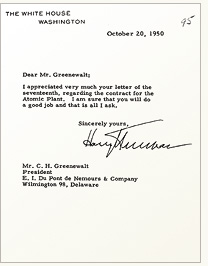
1950:
• E. I. duPont de Nemours and Company was asked by the Atomic Energy Commission to design, construct and manage the Savannah River Plant.
• An area for the site was chosen.
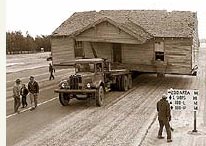
1951:
• Savannah River Ecology Laboratory begins ecological studies of SRS plants and animals.
• Construction began at the site.
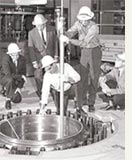
1952:
• Production of heavy water for site reactors begins in Heavy Water Rework Facility.
1953:
• R-Reactor, the first production reactor, goes critical.

1954:
• P-Reactor, L-Reactor, K-Reactor go critical.
• The first irradiated fuel is discharged.
• F-Canyon, a chemical separation facility, begins radioactive operations.
1955:
• C-Reactor goes critical.
• The first plutonium shipment leaves the site.
• H-Canyon, a chemical separation facility, begins radioactive operations.
BACK TO TOP
1956:
• Construction of the basic plant is complete.
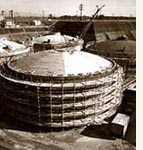
1963:
• Receiving Basin for Off-Site Fuels receives first shipment of off-site spent nuclear fuel.
1964:
• R-Reactor shut down.
1968:
• L-Reactor shut down for upgrades.
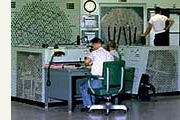
1971:
• K-Reactor becomes the first production reactor automatically controlled by computer.
1972:
• The site is designated as the first National Environmental Research Park.
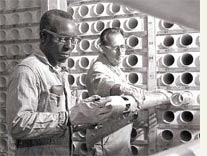 1981: 1981:
• SRS begins environmental cleanup program.
• M-Area Settling Basin cleanup begins under the Resource Conservation and Recovery Act.

1982:
• Heavy Water Rework Facility closed.
1983:
• Ground is broken for construction of the Defense Waste Processing Facility.
• Wackenhut Services Incorporated begins providing security support services at SRS.
BACK TO TOP

1985:
• HB-Line begins producing plutonium-238 for NASA's deep-spaceexploration program.
• L-Reactor restarted and C-Reactor shut down.
• A full-scale groundwater remediation system constructed in M-Area.
1986:
• Construction of Saltstone begins.
• Construction of the Replacement Tritium Facility begins.
1987:
• duPont notifies DOE that it will not continue to operate and manage the site.
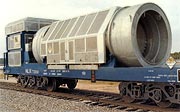
1988:
• K-, L- and P-Reactors were shut down.
• Effluent Treatment Facility begins operations to treat low-level radioactive wastewater from F- and H-Area Separations facilities.
1989:
• The site is officially included on the National Priority List and becomes regulated by EPA.
 • Westinghouse Savannah River Company assumes management and operation of site facilities. • Westinghouse Savannah River Company assumes management and operation of site facilities.
BACK TO TOP
1990:
• Construction of a cooling tower for K-Reactor begins.
• Saltstone operations begin.
1991:
• Mixed Waste Management Facility: first SRS facility closed and certified under the provisions of the Resource Conservation and Recovery Act.
• L-Reactor shut down.
• M-Area Settling Basin closure completed.
• Cold War ends and production of nuclear materials for weapons at SRS stops.
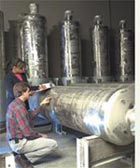
1992:
• K-Reactor operated briefly for last time and connected to cooling tower.
• Secretary of Energy announces phase out of all uranium processing.
• Non-radioactive operations begin at the Replacement Tritium Facility.
1993:
• K-Reactor placed in cold-standby condition as Nation's tritium source.
• Non-radioactive test runs of the Defense Waste Processing Facility begin.
• Construction begins on Consolidated Incineration Facility.
• Tritium introduced into the Replacement Tritium Facility and radioactive operations begins.
• Workforce Transition and Community Assistance begins at SRS.

1994:
• SRS Citizens Advisory Board was established.
1996:
• The Defense Waste Processing Facility introduces radioactive material into the vitrification process.
• K-Reactor placed in shutdown condition.
• F-Canyon restarts and begins stabilizing nuclear materials at SRS.
1997:
• First high-level radioactive waste tanks closed.
BACK TO TOP
 2000: 2000:
• K-Reactor building converted to K Area Materials Storage Facility.
• Record of Decision announced, selecting SRS as the site of new plutonium missions:
- MOX Fuel Fabrication Facility
- Pit Disassembly and Conversion Facility
- Plutonium Immobilization Facility
2002:
• F Canyon and FB Line facilities completed their last production run to process legacy materials.
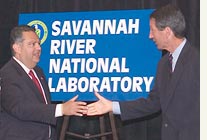 2003: 2003:
• Last depleted uranium metal shipped to Envirocare of Utah.
• Receiving Basin for Offsite Fuels prepares for closure.
2004:
• Site's research laboratory designated as a national laboratory.
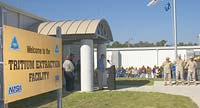
2005:
• Blended low-enriched uranium from SRS used by Tennessee Valley Authority reactor to generate electricity.
• Tritium Facilities Modernization & Consolidation Project completed start-up.

2006:
• Savannah River National Laboratory designated as the Office of Environmental Management’s "Corporate Laboratory."
• Aiken County’s new Center for Hydrogen Research opened its doors.
• F-Area deactivation work complete.
• T-Area closure complete.
2008:
• Historical markers were placed in P and R Areas commemorating the role played by P- and R-Reactor towards winning the Cold War. The site’s first two nuclear production reactors, R-Reactor began operations in 1953, P-Reactor in 1954.
BACK TO TOP |



